
A temple is a building reserved for spiritual rituals and activities such as prayer and sacrifice. Religions which erect temples include Christianity, Hinduism, Buddhism, Sikhism, Jainism, Islam, Judaism, Zoroastrianism, the Baha'i Faith, Taoism, Shintoism, Confucianism, and ancient religions such as the Ancient Egyptian religion and the Ancient Greek religion.
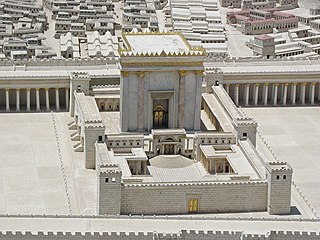
The Second Temple, also known in its later years as Herod's Temple, was the reconstructed Jewish holy temple that stood on the Temple Mount in the city of Jerusalem between c. 516 BCE and 70 CE. It replaced the First Temple that had been destroyed in 587 BCE by the Neo-Babylonian Empire during its conquest of the Kingdom of Judah; the fallen Jewish kingdom was subsequently annexed as a Babylonian province and part of its populace was held captive in Babylon. Construction on the Second Temple began some time after the conquest of Babylon by the Achaemenid Persian Empire, following a proclamation by the Persian king Cyrus the Great that enabled the Jewish return to Zion. The completion of the Second Temple in the new Achaemenid province of Yehud marked the beginning of the Second Temple period in Jewish history.

Lakshmi, also known as Shri, is one of the principal goddesses in Hinduism. She is the goddess of wealth, fortune, power, beauty, fertility and prosperity, and associated with Maya ("Illusion"). Along with Parvati and Saraswati, she forms the Tridevi of Hindu goddesses.

Angkor Wat is a temple complex in Cambodia and is the largest religious monument in the world, on a site measuring 162.6 hectares. Originally constructed as a Hindu temple dedicated to the god Vishnu for the Khmer Empire by King Suryavarman II, it was gradually transformed into a Buddhist temple towards the end of the 12th century; as such, it is also described as a "Hindu-Buddhist" temple.

The Peoples Temple Agricultural Project, better known by its informal name "Jonestown", was a remote settlement in Guyana established by the Peoples Temple, a U.S.–based cult under the leadership of Jim Jones. Jonestown became internationally infamous when, on November 18, 1978, a total of 909 people died at the settlement, at the nearby airstrip in Port Kaituma, and at a Temple-run building in Georgetown, Guyana's capital city. The name of the settlement became synonymous with the incidents at those locations.

James Warren Jones was an American preacher, political activist and mass murderer. He led the Peoples Temple, a new religious movement, between 1955 and 1978. In what he called "revolutionary suicide", Jones and the members of his inner circle orchestrated a mass murder–suicide in his remote jungle commune at Jonestown, Guyana, on November 18, 1978. Jones and the events which occurred at Jonestown have had a defining influence on society's perception of cults.
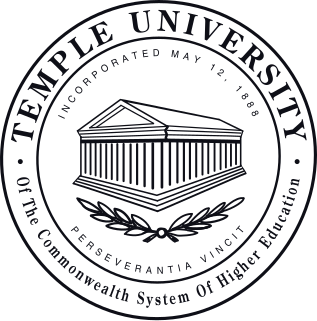
Temple University is a public state-related research university in Philadelphia, Pennsylvania. It was founded in 1884 by the Baptist minister Russell Conwell and his congregation Grace Baptist Church of Philadelphia then called Baptist Temple. On May 12, 1888, it was renamed the Temple College of Philadelphia. By 1907, the institution revised its institutional status and was incorporated as a research university.

Shirley Temple Black was an American actress, singer, dancer, and diplomat who was Hollywood's number one box-office draw as a child actress from 1934 to 1938. Later, she was named United States ambassador to Ghana and Czechoslovakia, and also served as Chief of Protocol of the United States.

Rajaraja I, born Arunmozhi Varman or Arumozhi Varman and often described as Raja Raja the Great or Raja Raja Chozhan was a Chola emperor who reigned from 985 CE to 1014 CE. He was the most powerful king in south India during his reign and is remembered for reinstating the Chola influence and ensuring its supremacy across the Indian Ocean.

A Hindu temple, or mandir or koil in Indian languages, is a house, seat and body of divinity for Hindus. It is a structure designed to bring human beings and gods together through worship, sacrifice, and devotion. The symbolism and structure of a Hindu temple are rooted in Vedic traditions, deploying circles and squares. It also represents recursion and the representation of the equivalence of the macrocosm and the microcosm by astronomical numbers, and by "specific alignments related to the geography of the place and the presumed linkages of the deity and the patron". A temple incorporates all elements of the Hindu cosmos — presenting the good, the evil and the human, as well as the elements of the Hindu sense of cyclic time and the essence of life — symbolically presenting dharma, artha, kama, moksa, and karma.

The Chola Dynasty was a Tamil thalassocratic empire of southern India and one of the longest-ruling dynasties in world history. The earliest datable references to the Chola are from inscriptions dated to the 3rd century BCE during the reign of Ashoka of the Maurya Empire. As one of the Three Crowned Kings of Tamilakam, along with the Chera and Pandya, the dynasty continued to govern over varying territories until the 13th century CE. Despite these ancient origins, the rise of the Chola, as the "Chola Empire," only begins with the medieval Cholas in the mid-9th century CE.
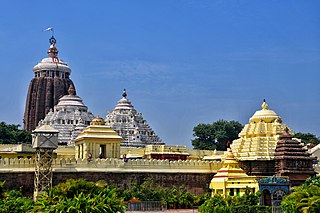
The Jagannath Temple is an important Hindu temple dedicated to Jagannath, a form of Vishnu - one of the trinity of supreme divinity in Hinduism, Puri is in the state of Odisha on the eastern coast of India. The present temple was rebuilt from the 10th century onwards, on the site of pre existing temples in the compound but not the main Jagannatha temple, and begun by Anantavarman Chodaganga, the first king of the Eastern Ganga dynasty.

Arulmigu Meenakshi Amman Temple, also known as Shri Meenakshi Sundareshwarar Temple, is a historic Hindu temple located on the southern bank of the Vaigai River in the temple city of Madurai, Tamil Nadu, India. It is dedicated to the goddess Meenakshi, a form of Parvati, and her consort, Sundareshwarar, a form of Shiva. The temple is at the center of the ancient temple city of Madurai mentioned in the Tamil Sangam literature, with the goddess temple mentioned in 6th-century-CE texts. This temple is one of the Paadal Petra Sthalams. The Paadal Petra sthalams are 275 temples of lord Shiva that are revered in the verses of Tamil Saiva Nayanars of 6th-9th century CE.

Kedarnath Temple is a Hindu temple dedicated to Lord Shiva. The temple is located in the Garhwal Himalayan range near the Mandakini river in Uttarakhand, India. Due to extreme weather conditions, the temple is open to the general public only between April and November. During the winters, the vigraha (deity) of the temple is carried down to Ukhimath to be worshipped for the next six months. Kedarnath is seen as a homogenous form of Shiva, the 'Lord of Kedarkhand', the region's historical name.[1]

Brihadishvara Temple locally known as Thanjai Periya Kovil, and also called Peruvudaiyar Kovil, is a Hindu Saivite temple built based on Chola architecture dedicated to the lord Shiva located in South bank of Cauvery river in Thanjavur, Tamil Nadu, India. It is one of the largest Hindu temples and an exemplar of fully realized Tamil architecture. It is called as Dakshina Meru. Built by Chola emperor Rajaraja I between 1003 and 1010 CE, the temple is a part of the UNESCO World Heritage Site known as the "Great Living Chola Temples", along with the Chola dynasty era Gangaikonda Cholapuram temple and Airavatesvara temple that is about 70 kilometres (43 mi) and 40 kilometres (25 mi) to its northeast respectively.
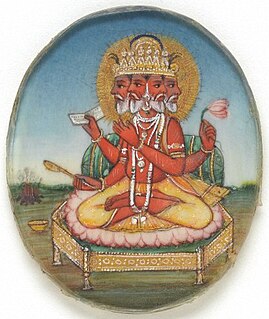
Brahma is a Hindu god, referred to as "the Creator" within the Trimurti, the trinity of supreme divinity that includes Vishnu, and Shiva. He is associated with creation, knowledge, and the Vedas. Brahma is prominently mentioned in creation legends. In some Puranas, he created himself in a golden embryo known as the Hiranyagarbha.

The Golden Temple is a gurdwara located in the city of Amritsar, Punjab, India. It is the preeminent spiritual site of Sikhism. It is one of the holiest sites in Sikhism, alongside the Gurdwara Darbar Sahib Kartarpur in Kartarpur, and Gurdwara Janam Asthan in Nankana Sahib.
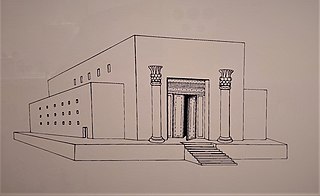
Solomon's Temple, also known as the First Temple, is the name of a temple in Jerusalem, which, according to the Hebrew Bible, was built during the reign of King Solomon. It was destroyed in 587/586 BCE by the Neo-Babylonian Empire under the second Babylonian king, Nebuchadnezzar II. Although most scholars today agree that a temple existed on the Temple Mount by the time of the Babylonian siege, its construction date and the identity of its builder are debated.
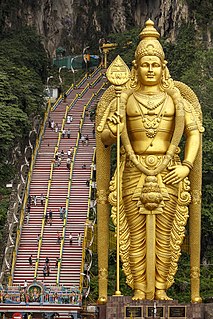
Kartikeya, also known as Skanda, Subrahmanya, Shanmukha, and Murugan, is the Hindu god of war. He is the son of Parvati and Shiva, the brother of Ganesha and a god whose legends have many versions in Hinduism. Kartikeya has been an important deity in the Indian subcontinent since ancient times, worshipped as Mahasena and Kumara in North India and is predominantly worshipped in the state of Tamil Nadu and other parts of South India, Sri Lanka, Singapore, and Malaysia as Murugan.
Tirunellikka Nellivananathar Temple is a Hindu temple located at Tirunellikka in Tiruvarur district, Tamil Nadu, India. The temple is dedicated to Shiva, as the moolavar presiding deity, in his manifestation as Nellivananathar. His consort, Parvati, is known as Mangalanayaki.



















